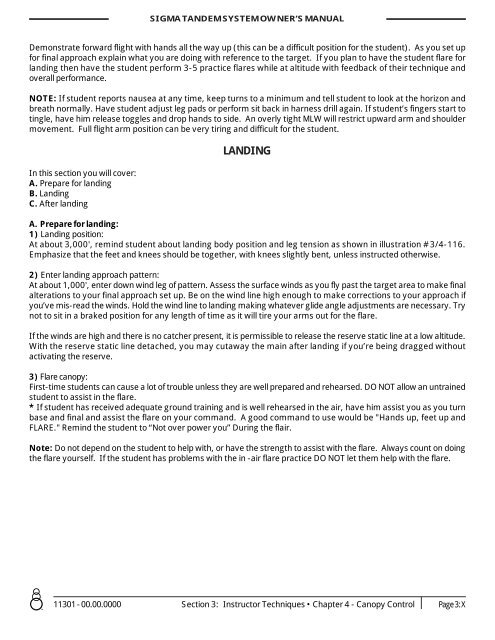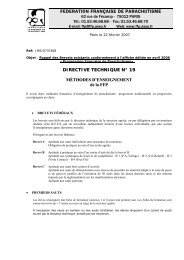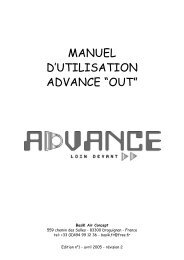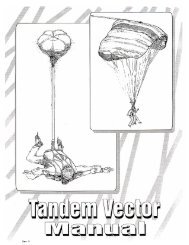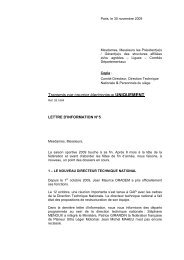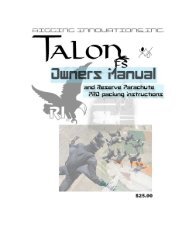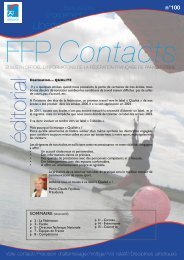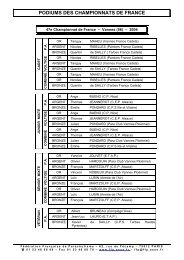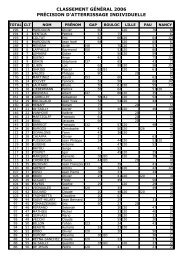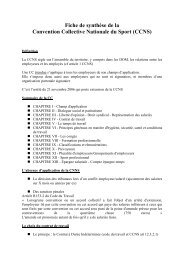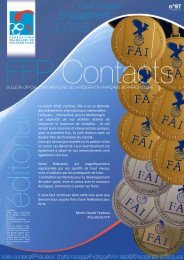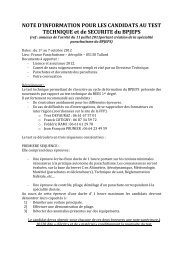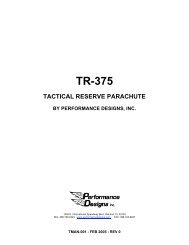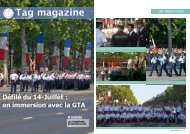tandem vector owner's manual
tandem vector owner's manual
tandem vector owner's manual
Create successful ePaper yourself
Turn your PDF publications into a flip-book with our unique Google optimized e-Paper software.
SIGMA TANDEM SYSTEM OWNER’S MANUAL<br />
Demonstrate forward flight with hands all the way up (this can be a difficult position for the student). As you set up<br />
for final approach explain what you are doing with reference to the target. If you plan to have the student flare for<br />
landing then have the student perform 3-5 practice flares while at altitude with feedback of their technique and<br />
overall performance.<br />
NOTE: If student reports nausea at any time, keep turns to a minimum and tell student to look at the horizon and<br />
breath normally. Have student adjust leg pads or perform sit back in harness drill again. If student’s fingers start to<br />
tingle, have him release toggles and drop hands to side. An overly tight MLW will restrict upward arm and shoulder<br />
movement. Full flight arm position can be very tiring and difficult for the student.<br />
In this section you will cover:<br />
A. Prepare for landing<br />
B. Landing<br />
C. After landing<br />
LANDING<br />
A. Prepare for landing:<br />
1) Landing position:<br />
At about 3,000', remind student about landing body position and leg tension as shown in illustration #3/4-116.<br />
Emphasize that the feet and knees should be together, with knees slightly bent, unless instructed otherwise.<br />
2) Enter landing approach pattern:<br />
At about 1,000', enter down wind leg of pattern. Assess the surface winds as you fly past the target area to make final<br />
alterations to your final approach set up. Be on the wind line high enough to make corrections to your approach if<br />
you’ve mis-read the winds. Hold the wind line to landing making whatever glide angle adjustments are necessary. Try<br />
not to sit in a braked position for any length of time as it will tire your arms out for the flare.<br />
If the winds are high and there is no catcher present, it is permissible to release the reserve static line at a low altitude.<br />
With the reserve static line detached, you may cutaway the main after landing if you’re being dragged without<br />
activating the reserve.<br />
3) Flare canopy:<br />
First-time students can cause a lot of trouble unless they are well prepared and rehearsed. DO NOT allow an untrained<br />
student to assist in the flare.<br />
* If student has received adequate ground training and is well rehearsed in the air, have him assist you as you turn<br />
base and final and assist the flare on your command. A good command to use would be "Hands up, feet up and<br />
FLARE." Remind the student to “Not over power you” During the flair.<br />
Note: Do not depend on the student to help with, or have the strength to assist with the flare. Always count on doing<br />
the flare yourself. If the student has problems with the in -air flare practice DO NOT let them help with the flare.<br />
11301 - 00.00.0000 Section 3: Instructor Techniques • Chapter 4 - Canopy Control<br />
Page 3:X


